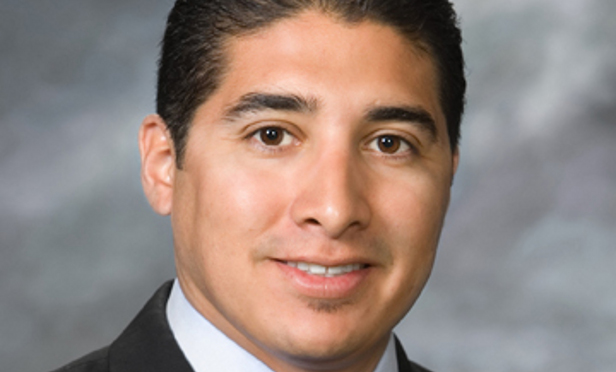
NEWPORT BEACH, CA—Strip centers offer an investor a prudent hedge against future inflation if there is a jump in long-term treasury rates, CBRE investment sales advisor Arthur Flores tells GlobeSt.com. The firm was recently involved in the sale of Brea Imperial Shopping Center in Brea, CA, to an Orange County-based partnership for approximately $21.06 million. The 4.95% cap rate was among the lowest in the county this year for a strip center. We spoke exclusively with Flores about trends in Orange County's retail sector and the market for strip centers in this region.
GlobeSt.com: What new trends are you noticing among the retail sector in Orange County?
Flores: It is no surprise that class-A assets or true value-add retail in core locations in Orange County remain extremely desirable for both private and institutional capital. A recent shift in trends is the increasing investor interest driving cap-rate compression in well-located, unanchored, multi-tenant retail centers. An example of this is Brea Imperial Center, which my team recently marketed and sold. Due to competitive bidding, the unanchored shopping center sold for $21 million, representing a 4.95% cap rate; a full $1 million over the list price. Private capital, such as the buyer of Brea Imperial Center, can take advantage of modest leverage with fixed-rate debt, allowing an investor to realize yield far superior to other non-tangible investment vehicles, such as stocks and bonds. Further, the market is rewarding quick-serve restaurants, light-fitness or service-retail tenancy, all of which offer an investor a hedge against rising interest rates and security against Internet competition.
GlobeSt.com: We hear a lot about the large retail centers there, but how would you characterize this market for strip-center retail?
Flores: If there is a jump in long-term treasury rates, multi-tenant strip centers typically provide an investor with a net-operating-income lift due to embedded increases in leases and tenant rolling. That means they offer an investor a prudent hedge against future inflation.
GlobeSt.com: Which types of retailers are best for strip centers in Orange County?
Flores: The most active strip centers in Orange County are multi-tenant strip centers featuring a line-up that is resistant to the risk of Internet competition. Preferred uses in today's market may include quick-service restaurants and national coffee chains, fitness uses and traditional service tenants such as dentists, nail and hair salons. All of these cannot be replicated online.
GlobeSt.com: What else should our readers know about Orange County retail?
Flores: The retail landscape is ever evolving. Many traditional “big-box” retailers are focused on “right-sizing,” and in some cases, amassing a significant online presence and creating more efficient omni-channel operations to compete with exclusive online retailers. Investors just need to be sure to stay ahead of the changing retail curve and focus on uses that are experience focused and are difficult to replicate by online retailers.

NEWPORT BEACH, CA—Strip centers offer an investor a prudent hedge against future inflation if there is a jump in long-term treasury rates, CBRE investment sales advisor Arthur Flores tells GlobeSt.com. The firm was recently involved in the sale of Brea Imperial Shopping Center in Brea, CA, to an Orange County-based partnership for approximately $21.06 million. The 4.95% cap rate was among the lowest in the county this year for a strip center. We spoke exclusively with Flores about trends in Orange County's retail sector and the market for strip centers in this region.
GlobeSt.com: What new trends are you noticing among the retail sector in Orange County?
Flores: It is no surprise that class-A assets or true value-add retail in core locations in Orange County remain extremely desirable for both private and institutional capital. A recent shift in trends is the increasing investor interest driving cap-rate compression in well-located, unanchored, multi-tenant retail centers. An example of this is Brea Imperial Center, which my team recently marketed and sold. Due to competitive bidding, the unanchored shopping center sold for $21 million, representing a 4.95% cap rate; a full $1 million over the list price. Private capital, such as the buyer of Brea Imperial Center, can take advantage of modest leverage with fixed-rate debt, allowing an investor to realize yield far superior to other non-tangible investment vehicles, such as stocks and bonds. Further, the market is rewarding quick-serve restaurants, light-fitness or service-retail tenancy, all of which offer an investor a hedge against rising interest rates and security against Internet competition.
GlobeSt.com: We hear a lot about the large retail centers there, but how would you characterize this market for strip-center retail?
Flores: If there is a jump in long-term treasury rates, multi-tenant strip centers typically provide an investor with a net-operating-income lift due to embedded increases in leases and tenant rolling. That means they offer an investor a prudent hedge against future inflation.
GlobeSt.com: Which types of retailers are best for strip centers in Orange County?
Flores: The most active strip centers in Orange County are multi-tenant strip centers featuring a line-up that is resistant to the risk of Internet competition. Preferred uses in today's market may include quick-service restaurants and national coffee chains, fitness uses and traditional service tenants such as dentists, nail and hair salons. All of these cannot be replicated online.
GlobeSt.com: What else should our readers know about Orange County retail?
Flores: The retail landscape is ever evolving. Many traditional “big-box” retailers are focused on “right-sizing,” and in some cases, amassing a significant online presence and creating more efficient omni-channel operations to compete with exclusive online retailers. Investors just need to be sure to stay ahead of the changing retail curve and focus on uses that are experience focused and are difficult to replicate by online retailers.
© 2025 ALM Global, LLC, All Rights Reserved. Request academic re-use from www.copyright.com. All other uses, submit a request to [email protected]. For more information visit Asset & Logo Licensing.








